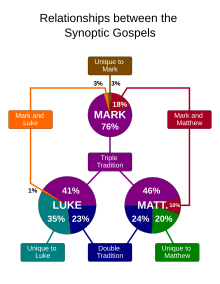
In textual criticism of the New Testament, the L source is a hypothetical oral or textual tradition which the author of Luke–Acts may have used when composing the Gospel of Luke.
Composition
The question of how to explain the similarities among the Gospels Matthew, Mark, and Luke is known as the synoptic problem. The hypothetical L source fits a contemporary solution in which Mark was the first gospel and Q was a written source for both Matthew and Luke. According to the four-document hypothesis, the author combined Mark, the Q source, and L to produce his gospel. The material in L, like that in M, probably comes from the oral tradition. I. Howard Marshall (1994) stated: "Luke rightly regarded these sources as reliable".
James R. Edwards (2009) equated the L source with the Hebrew Gospel referred to by patristic authors. His thesis has not been accepted by other scholars.
Contents

According to Honoré (1968), the unique material in the third Gospel (termed "L") amounted to 35% of that gospel. Theissen (1998) went further, stating that the special material comprises nearly half of the Gospel of Luke.
L includes the Annunciation, the Visitation, the Lukan account of the virgin birth of Jesus (including the Adoration of the Shepherds, the Circumcision and Presentation of Jesus at the Temple), the Finding in the Temple, many parables of Jesus, and Jesus at Herod's court. Like Matthew's unique source, known as M, the L source has several parables such as the Parable of the Good Samaritan (Luke 10:25–37) and the Parable of the Prodigal Son (Luke 15:11–32).
According to E. Earle Ellis (1999), the L source material exhibits the highest prevalence of Semitisms within the Luke–Acts corpus, so that Semitic sources were probably at the basis of L source verses such as Luke 1:5–2:40; 5:1–11; 7:11–17, 36–50; 8:1–3; 9:51–56; 11:27f.; 13:10–17; 14:1–6; 17:11–19; 19:1–10; 23:50–24:53. By contrast, the portions of the Gospel of Luke that parallel the contents of the Gospel of Mark represented 'a more polished Greek' than Mark's, and show fewer Hebraisms.
See also
- Authorship of Luke–Acts
- Criterion of multiple attestation
- Mary, mother of Jesus
- M source
- List of Gospels
- Marcion hypothesis
References
- ^ Funk, Robert Walter; Hoover, Roy W.; Jesus Seminar (1993). "Introduction". The Five Gospels: The Search for the Authentic Words of Jesus. New Translation and Commentary. HarperSanFrancisco. pp. 1–30. ISBN 978-0-02-541949-0.
- Jones, Brice (2011). Matthean and Lukan Special Material: A Brief Introduction with Texts in Greek and English. Wipf and Stock Publishers. ISBN 978-1-61097-737-1. Archived from the original on 2014-05-31. Retrieved 2012-02-01.
- Marshall, I. Howard (1994). "LUKE. Introduction". In Carson, D. A.; et al. (eds.). New Bible Commentary: 21st Century Edition. Inter-Varsity Press. p. 979. ISBN 978-0-85110-648-9.
- Edwards, James (2009). The Hebrew Gospel and the development of the synoptic tradition. Grand Rapids, Michigan: Eerdmans. ISBN 978-0-8028-6234-1. OCLC 368048433.
- Friedrichsen, Timothy A. (2010). "Book review: The Hebrew Gospel and the Development of the Synoptic Tradition" (PDF). Review of Biblical Literature.
- Sweeney, James P. (2010). "Book review: The Hebrew Gospel and the Development of the Synoptic Tradition" (PDF). Review of Biblical Literature. Archived from the original (PDF) on 2020-10-27. Retrieved 2020-08-12.
- Kloppenborg, John S. (2011-04-14). "The Hebrew Gospel and the Development of the Synoptic Tradition (review)". Toronto Journal of Theology. 27 (1): 109–111. doi:10.1353/tjt.2011.0000. ISSN 1918-6371. S2CID 144873030.
- ^ Honoré, A.M. (1968). "A statistical study of the synoptic problem". Novum Testamentum. 10 (2/3): 95–147. doi:10.2307/1560364. JSTOR 1560364.
- Theissen, Gerd; Merz, Annette (1998). "Chapter 2. Christian sources about Jesus.". The Historical Jesus: A Comprehensive Guide. Translated from German (1996 edition). Fortress Press. ISBN 978-0-8006-3123-9.
- ^ Ellis, E. Earle (1999). "The Origin and Making of Luke-Acts" (PDF). The Making of the New Testament Documents. Leiden: Brill. pp. 387–388. ISBN 9780391041684. (PDF)
| Synoptic problem | |
|---|---|
| The Synoptic Gospels | |
| Matthaean priority | |
| Marcan priority | |
| Lucan priority | |
| Other or no priority | |
| Possible sources | |